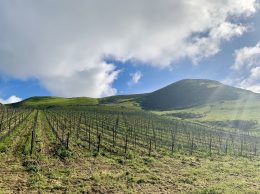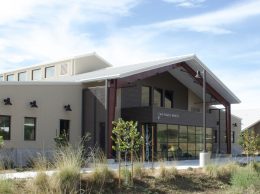Vintners measure ‘soul’ of their wine with phenolics testing
IN THIS ARTICLE
- Columns Topic
- Tom Bronzini Author
By Tom Bronzini Friday, April 17th, 2015
A small number of Central Coast winemakers have begun using a desktop-sized device to measure chemical compounds that have been called the “soul” of the wine.
They are analyzing phenolic levels in robust red wines like cabernet sauvignon and syrah to help them make more reliable decisions on when to separate the juice from skins and stems, and how to blend to achieve consistent structure in successive vintages. They can run a test in less than 15 minutes that tells them the levels of phenols related to color, mouthfeel and structure. The test also reveals a property known as bound color.
“And that bound color has been seen in the phenolic world as the soul of the wine,” said Kevin Sass, winemaker at Halter Ranch Vineyard in Paso Robles, who has been using phenolics analysis since 2012. “So the more you have of that, the bigger the wine feels on your palate, the sweeter (in texture) it feels, the richer it feels and probably most importantly, it’s shown that the wine ultimately lasts longer by having that level higher.”
In the subjective world of wine, phenolics are in some ways an objective measure of quality. They measure properties that will likely separate a $20 bottle of wine from a $35 bottle and a $50 and above bottle.
Daniel Daou, co-owner and winemaker at Daou Vineyards & Winery in Paso Robles, said the test device he is now using has in his mind shifted the balance between the art and science of winemaking. “There’s still an art component to it,” he said, “but I think what I find is normally it’s 70 percent maybe art, 30 percent science, but with phenolics I tend to feel like it’s more 50-50.”
Grapes contain hundreds of phenolic compounds. A test has been available since around 2002 that measures chemical compounds in wine called anthocyanins, related to color, and tannins, which react with saliva in the mouth to produce astringency and mouthfeel. The procedure is complicated and requires about four hours to obtain results, limiting its usefulness.
A Napa Valley company called WineXray developed a test that takes less than 15 minutes. A sample of wine is run through a desktop-size spectrophotometer, which uses ultraviolet light to analyze it. Values are uploaded into a cloud system and results come back in less than a minute.
Sass adopted phenolics measurement after a disastrous experience with a batch of syrah in 2011. He over-extracted tannins while the syrah was fermenting on the skins, even though he had been tasting and monitoring it. “It was so tannic your tongue stuck to the roof of your mouth,” he said, “and so we ended up selling it off as bulk wine to somebody else.”
Sass said it is difficult to accurately taste tannin levels through the sugar, and astringency can build up quickly in later stages of fermentation.
In 2013, Daou over-extracted a tank of wine even though he was taking phenolics readings every morning, thinking that was a lot. “Well guess what? I missed it, because in a period of 24 hours, the tannins jumped up by 100 percent,” he said. Last year, he began measuring phenolics morning and night. “I nailed every one,” he said.
The testing, done before contact of the wine with oak, does a lot more than help eliminate costly mistakes. It helps winemakers consistently achieve profiles they want for their tiers of wines.
When the red wine is fermenting on the skins, compounds called free anthocyanins, related to color, bind with tannins in a one-to-one ratio to form bound anthocyanins, or bound color. That is the backbone or “soul” of the wine. The bound color remains stable over many years. Along with flavor profiles, a high level of bound color in a red wine will make it a candidate for reserve status if the color and tannins are nicely balanced.
Phenolic development is affected by many things, including soil, grape variety, clone and rootstock, sunlight, canopy, berry size and possibly viruses, so bound color potential varies a lot. Sass and Daou are adding equipment this season to measure phenolics in the vineyard as the grapes mature.
Scott McLeod of WineXray said in an email that the company does a lot of work in the Napa Valley and currently has four clients in San Luis Obispo County. He expects that number to double by harvest time. Equipment costs $3,000 to $5,000, and clients pay for each test result. Daou said the technology is becoming more affordable, with licensing deals available for wineries that run many tests.
Daou said that when he feels he has produced a great wine, phenolics analysis is lifted to a different level. “When you start making wine the year after, you’re tracking phenolics every day, and you go, ‘I hit it, right now, don’t miss it,’” he said.
• Contact Tom Bronzini at [email protected].










